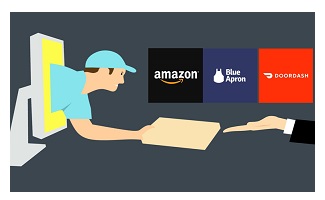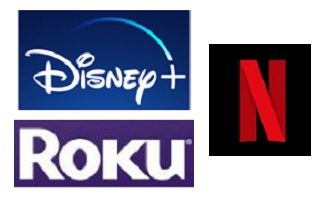eResearch | This week, companies focused on remote workplace technologies reported calendar Q1/2020 earnings, including Dropbox Inc. (NASDAQ: DBX), Slack Technologies Inc. (NYSE: WORK), and Zoom Video Communication Inc. (NASDAQ: ZM).
As the COVID-19 pandemic continues, platforms for remote communication and data management experienced a surge in demand as customers transitioned online through three key areas of digital transformation: (1) cloud storage, (2) workplace communication, and (3) video conferencing.
In light of the lockdowns, several online-based technology companies have announced plans to allow employees to work permanently from home, including Twitter Inc. (NYSE: TWTR), Shopify Inc. (TSX: SHOP), and Facebook Inc. (NASDAQ: FB).
More information on companies exiting office real-estate spaces can be found in the article published last week called “Impacts to Office Real-Estate Space as Twitter, Shopify, and Facebook Announce Permanent Remote Work Standards”
Dropbox
 In Q1/2020, Dropbox reported revenue growth of 18% to US$455 million, with record gross margins of 77%. Net Income improved to US$39 million from a loss of US$7.7 million in Q1/2019, attributed to greater efficiencies in marketing spend with higher increases in revenue than expenses.
In Q1/2020, Dropbox reported revenue growth of 18% to US$455 million, with record gross margins of 77%. Net Income improved to US$39 million from a loss of US$7.7 million in Q1/2019, attributed to greater efficiencies in marketing spend with higher increases in revenue than expenses.
Dropbox benefited as its file sharing platform supports businesses of all sizes transition to remote work environments, with Dropbox also moving the majority of its operations remotely.
As lockdowns continued, Dropbox experienced a ramp up in demand for the number of consumers signing up for free trials. Since the onset of the pandemic, trials for Dropbox’s corporate clients increased by 40%, while trials for individual users increased by 25%.
Dropbox’s HelloSign subsidiary, an e-signature company acquired last year, also reported increased demand as its customizable document workflow solution experienced three times the number of signature requests on average in recent months compared with the beginning of the year.
To further support remote work environments, Dropbox partnered up with Zoom, a leading videoconferencing platform, to allow users to securely share transcripts and recordings of Zoom calls without having to leave the Dropbox platform.
For Q2/2020 guidance, Dropbox expects revenue in the range of US$463 million to US$466 million, with an increase in forecasted 2020 revenue to US$1.91 billion from its previous guidance of US$1.88 billion.
Dropbox Q1/2020 Financial Highlights
- Revenue of US$455 million, an 18% increase year-over-year, with gross margins improving to 77% compared with 75% the prior year.
- Operating Expenses of US$325 million, a 5% increase year-over-year, due to R&D costs of US$182 million, a 21% increase year-over-year, Marketing costs of US$104 million, a 3% increase year-over-year, and SG&A costs of US$39 million, a 32% decrease year-over-year.
- Net income of US$39 million, up from a loss of US$7.7 million in Q1/2019.
- Balance sheet consists of Cash and Cash Equivalents, and Short-term Investments of US$1.1 billion, Current Liabilities of US$971 million, and Long-term Liabilities of US$946 million.
Slack
 In FQ1/2021, ended April 30, Slack reported revenue growth of 50% Y/Y to US$202 million, with gross margins maintained at 87%. However, net losses widened by 133% to US$74 million, attributed to a 30% increase in R&D expenses to US$61 million, used towards product development.
In FQ1/2021, ended April 30, Slack reported revenue growth of 50% Y/Y to US$202 million, with gross margins maintained at 87%. However, net losses widened by 133% to US$74 million, attributed to a 30% increase in R&D expenses to US$61 million, used towards product development.
In March, Slack decided to shift its whole operation to a remote work environment, as it followed numerous other companies who transitioned online.
Slack benefited from the shift to remote workplaces due to the pandemic, as it added a record 90,000 net new free and paid users on its platform, more than the previous fiscal year’s total user additions. Net new additions of paid customers grew by 12,000, a 28% increase year-over-year, expanding total paid users to 122,000, with a collective total of 750,000 free and paid users on the platform.
In addition to the dramatic increase in new users, Slack also experienced a 33% increase in the number of minutes that users spent on average on its platforms, from 90 minutes to 120 minutes per day when compared with the prior quarter.
As larger corporations seek to transition operations online, Slack ended the quarter with over 900 customers spending more than US$100,000 annually, a 49% increase year-over-year; new enterprise clients include Amazon.com, Inc. (NASDAQ: AMZN), Verizon Communications Inc. (NYSE: VZ), and Harvard University.
In light of the pandemic, to support customers struggling to meet obligations, Slack is currently offering short-term credits and installments, which increased deferred revenue by US$7 million.
For FQ2/2021, Slack expects revenue in the range of US$206 million to US$209 million and increased FY2021 revenue forecast in the range of US$855 million and US$870 million.
Slack FQ1/2021 Financial Highlights
- Revenue of US$202 million, a 50% increase year-over-year, with gross margins improving to 87% compared with 86% in the prior year.
- Operating Expenses of US$252 million, a 63% increase year-over-year, due to R&D costs of US$91 million, a 79% increase year-over-year, Marketing costs of US$110 million, a 65% increase year-over-year, and SG&A costs of US$51 million, a 38% increase year-over-year.
- Net loss of US$74 million, more than doubling its loss from a year ago.
- Balance sheet consists of Cash and Cash Equivalents, and Short-term Investments of US$1.5 billion, Current Liabilities of US$507 million, and Long-term Liabilities of US$811 million.
Zoom
 In FQ1/2021, Zoom reported a revenue growth of 169% Y/Y to US$328 million while operating expenses grew by only 109%, which increased Net Income to US$27 million from US$2.2 million in Q1/2019.
In FQ1/2021, Zoom reported a revenue growth of 169% Y/Y to US$328 million while operating expenses grew by only 109%, which increased Net Income to US$27 million from US$2.2 million in Q1/2019.
Throughout the pandemic, Zoom’s video communications platform has supported users in both the private and public sectors, including corporations, schools, and individuals, with the number of daily meeting participants reaching a total of 300 million.
As larger corporations transition meetings and communication online, the number of Zoom customers with more than 10 employees increased by 354% year-over-year. One of Zoom’s newly signed banking customers just deployed 175,000 licenses this quarter.
In addition to high growth in new enterprise customers, Zoom also experienced a 20x increase in its annualized meeting minutes run rate, with an increase in the number of total minutes to 2 trillion from 100 billion during the prior quarter.
During the onset of the pandemic, Zoom made its platform available to an unprecedented number of first-time customers. When privacy issues surfaced, the integrity of security controls was questioned. Some school districts banned the platform.
As a result, Zoom acquired Keybase, an end-to-end encryption company, who will support its 90-day plan on security and privacy, with plans to release Zoom 5.0, which should include new security features to allow enhanced control over meetings.
In light of COVID-19, Zoom has offered free services on its platform to over 100,000 schools in 25 countries, in addition to donating US$1.4 million to charities and creating a US$1 million support fund for education, social equity, and climate change.
For FQ2/2021 guidance, Zoom expects revenue in the range of US$495 million to US$500 million, with FY2021 revenue expected in the range of US$1.78 billion and US$1.8 billion.
Zoom FQ1/2021 Financial Highlights
- Revenue of US$328 million, a 169% increase year-over-year, with gross margins decreasing to 68% compared with 80% the prior year.
- Operating Expenses of US$201 million, a 109% increase year-over-year, due to R&D costs of US$26 million, a 91% increase year-over-year, Marketing costs of US$122 million, a 90% increase year-over-year, and SG&A costs of US$53 million, a 187% increase year-over-year.
- Net Income of US$27 million, up from US$2.2 million in Q1/2019.
- Balance sheet consists of Cash and Cash Equivalents, and Short-term investments of US$1.1 billion, Current Liabilities of US$1 billion, and Long-term Liabilities of US$132 million.
As the pandemic continues without any concrete timeline for a vaccine, Dropbox, Slack, and Zoom expect increases in demand as more companies announce permanent shifts from work place environments to work-from-home situations.
Since a large number of customers, driving the recent demand for remote workplace technologies, are just using the free trial, it will be interesting to see how many transition into paid customers.
To see highlights on last year’s earnings for Dropbox, Slack, and Zoom, please see our article published in March, called “Dropbox, Slack, and Zoom: Essential Technologies for Transforming Businesses into Remote Environments”
CHART 1: S&P 500 vs DBX, WORK, and ZM – 1 Year Financial Performance




